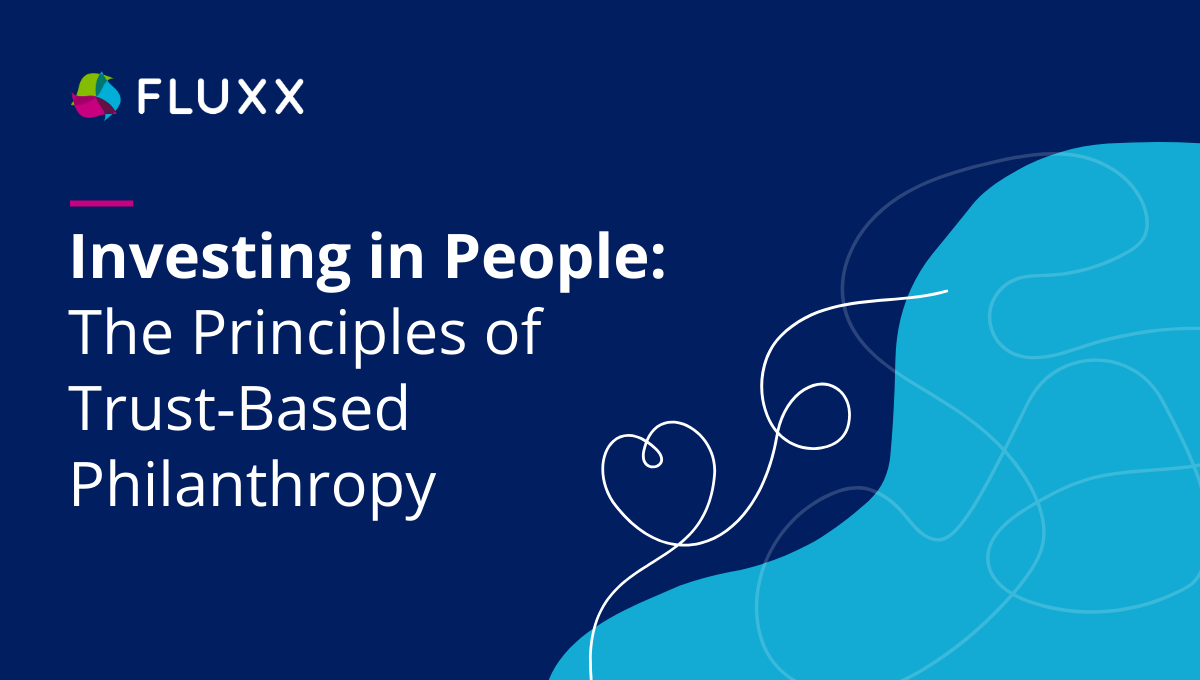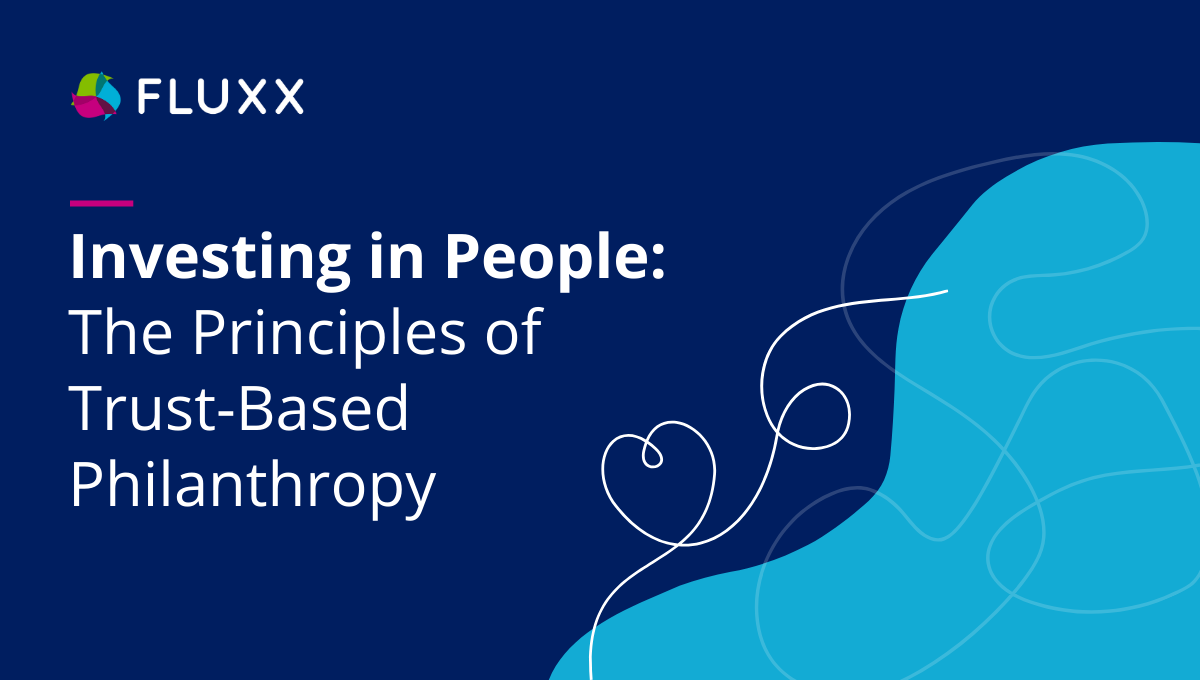The Alfred P. Sloan Foundation Finds Community in a 21st Century Grants Management Solution
By 2013 Anne McKissick, the director of grants management and information services at the Alfred P. Sloan Foundation, knew she needed a platform that...
Be the first to know about new Fluxx grants management resources, blog articles and podcasts.


The core of philanthropy is investing in people. It aims to support communities and individuals for a better world. However, the traditional philanthropy model has received criticism for perpetuating power imbalances, being too restrictive, and not focusing enough on the needs of those it aims to serve. Trust-based philanthropy addresses these issues by redistributing power, simplifying processes, and equitably investing in communities. This article will explore how to use the viable approach for a more equitable sector.
Trust-based philanthropy reframes grantmaking by dismantling inherent power structures and minimizing disproportionate restrictions. Instead of treating grantees as passive funding recipients, funders implement a collaborative strategy rooted in dialogue, mutual respect, shared goals, and decision-making.
Grantmaking often operates top-down, with the funding organization dictating the terms and imposing its goals and objectives on grantees. A trust-based practice emphasizes partnership and building confidence with grantees to identify community solutions. Follow these proven principles to implement a trust-based system with the most significant impact.
Applying for a grant award generally involves complex applications and reporting requirements that can hinder smaller and under-resourced organizations. For instance, they may not have a sophisticated monitoring and evaluation system and lack the data necessary to qualify for an award. Trust-based philanthropy recognizes that excessive paperwork can detract from a nonprofit’s mission. It simplifies the process by moving away from traditional grant applications, and oftentimes eliminating the application process for grantees, allowing them to focus on their mission and relationships rather than compliance.
For organizations new to grant-seeking, navigating the process can feel like breaking through a concrete ceiling. Simply understanding the terminology and creating a project budget may place additional stress on overworked staff members and organizational capacity. In a trust-based system, grantors are responsive to the needs of grantees. Funders consider how they distribute money to recipients, rather than the grantee presenting a line-item budget for potential funding. They communicate throughout the process so grantees know how their proposal is progressing.
This mutually beneficial approach improves your system for future recipients and ensures that you support the most underserved communities.
Funders don’t have all the answers to community development. But grantees often feel like they are at the whim of funders. No matter the needs of their demographic, they must create projects that satisfy the grantor to keep receiving money. This results in initiatives that don’t address the core issues, mission drift on behalf of the grantee, and perpetuate a disconnect between the funder and service communities.
Grantees should feel comfortable communicating their challenges and success. Trust-based giving actively seeks grantee input and insights and uses feedback to shape grantmaking strategies and procedures. By engaging in ongoing dialogue, you can better understand the needs and opportunities within recipient communities and adjust funding priorities accordingly.
In a trust-based system, money can’t solve every challenge, and funding alone is insufficient to create lasting change. It can even further exacerbate problems as grantees work to manage and allocate awards and meet requirements. Supporting grantees after funding distribution can help them leverage the opportunity for operational and programmatic improvements and become better change agents. Support may include capacity-building, networking recommendations, and technical advice.
Larger organizations have access to vast funding pools and donors. While smaller institutions often receive seed grants for short-term projects with inherent objectives to assess their ability to meet funder expectations. In 2020, organizations with expenses of $1 million or more were less likely to experience a decline in donations.
Trust-based philanthropy implements multi-year, unrestricted grants to empower grantees to lead their strategy and contribute to the long-term success of organizations and their beneficiaries. It alleviates the burden of constant fundraising and reporting and provides grantees flexibility and stability to pursue their goals.
Longer or open funding cycles also give smaller and disadvantaged organizations the time to work through operational kinks and demonstrate their commitment to growth.
Trust-based philanthropy offers a promising alternative to traditional grantmaking, but funders must deal with existing challenges and limitations. A trust-based method is only feasible when the barriers to equitable funding are identified and addressed by funders.
One of the biggest challenges of the traditional grantmaking model is the power imbalance between funders and grantees. Funders hold the purse strings, significantly influencing grantees’ work. Grantees feel they have to cater to funders’ priorities and preferences rather than pursue their mission and vision.
Funders must reform negative structures and redistribute power to grantees. In listening to grantees and empowering them to lead and drive mission change, funders become allies and not disruptors. When grantmakers are responsive to the priorities of recipients, grantees have the voice and power to amplify their work in place of funder objectives.
The individuals who are most affected by problems often have the best solutions. Local leaders frequently tackle complex issues that are difficult to measure, especially when dealing with social movements that aren’t quantified with numerical data. However, donors often use organizational budget size and metrics to assess grant eligibility. This method can perpetuate funding disparities and discriminatory decision-making.
By excluding smaller, under-resourced, community-based groups from grant opportunities in favor of more established organizations, the most equipped change agents don’t receive the resources essential to meaningful change. Using diverse methods to evaluate grantee activities, governance, and impact can help eradicate inequities.
Funders should reexamine the entire grantee evaluation process, from the initial interaction with organizations or individuals to the ultimate decision of funding and ongoing support. This approach will guarantee equal opportunity for all grantees to receive funding. A more equitable process will lead to a funder portfolio that mirrors gaps in community needs.
Most funding models distribute grants for specific projects and programs without considering the broader context in which these programs operate. Organizations must adhere to specific guidelines on how to spend money and requirements for matching funds, reporting, and evaluation. These restrictions can limit a grantee’s ability to innovate and adapt, creating a “one size fits all” solution that may not be appropriate for all organizations.
Trust-based philanthropy invests in communities more broadly, supporting organizations addressing systemic issues and building stronger communities.
It is much easier to get board members and grant committees excited about funding programs than office supplies. But grantmaking is about building sustainable organizations and leaders that scale impact. Operational and capacity-building support is essential to the viability of grant investments.
Instead of treating funding as the end goal, trust-based philanthropy perceives grantmaking as a tool for sustainability. Funders aren’t performance-focused but restrategize the award system to invest in areas that create lasting change.
Foundations sometimes struggle to promote equity for all ethnic and racial groups. Racial inequality is complicated and entrenched in society, making it challenging for foundations to know how to handle the issue. Discussing race is also a sensitive topic many people, including those working in foundations, tend to avoid.
Traditional giving operates in a race-neutral manner and doesn’t regard how race and racism impact the communities they serve. For example, a study found that organizations led by white directors had 24% larger budgets than those directed by people of color.
Trust-based philanthropy understands that a racial equity approach is not just about specific groups and considers how race influences power distribution and benefits among all societal groups.
This method acknowledges systemic racism in the public and the charitable sector and invests in organizations advancing equity and justice.
By building valuable relationships and investing in organizations more broadly, trust-based philanthropy can help redistribute power and advance racial equity. While implementing trust-based philanthropy can be challenging, it is an essential step towards evolving how we work to diversify giving and invest in long-term change that improves the lives of the most deserving beneficiaries.
Check out these resources to learn more about how trust-based philanthropy can help create a more equitable and effective philanthropic sector.
By 2013 Anne McKissick, the director of grants management and information services at the Alfred P. Sloan Foundation, knew she needed a platform that...
Learn about trust-based philanthropy and its impact on nonprofits. This guide explores principles, benefits, and strategies for building stronger...
AI is transforming the way businesses operate—but with great power comes great responsibility. As AI capabilities continue to expand, organizations...
Be the first to know about new Fluxx grants management resources, blog articles and podcasts.